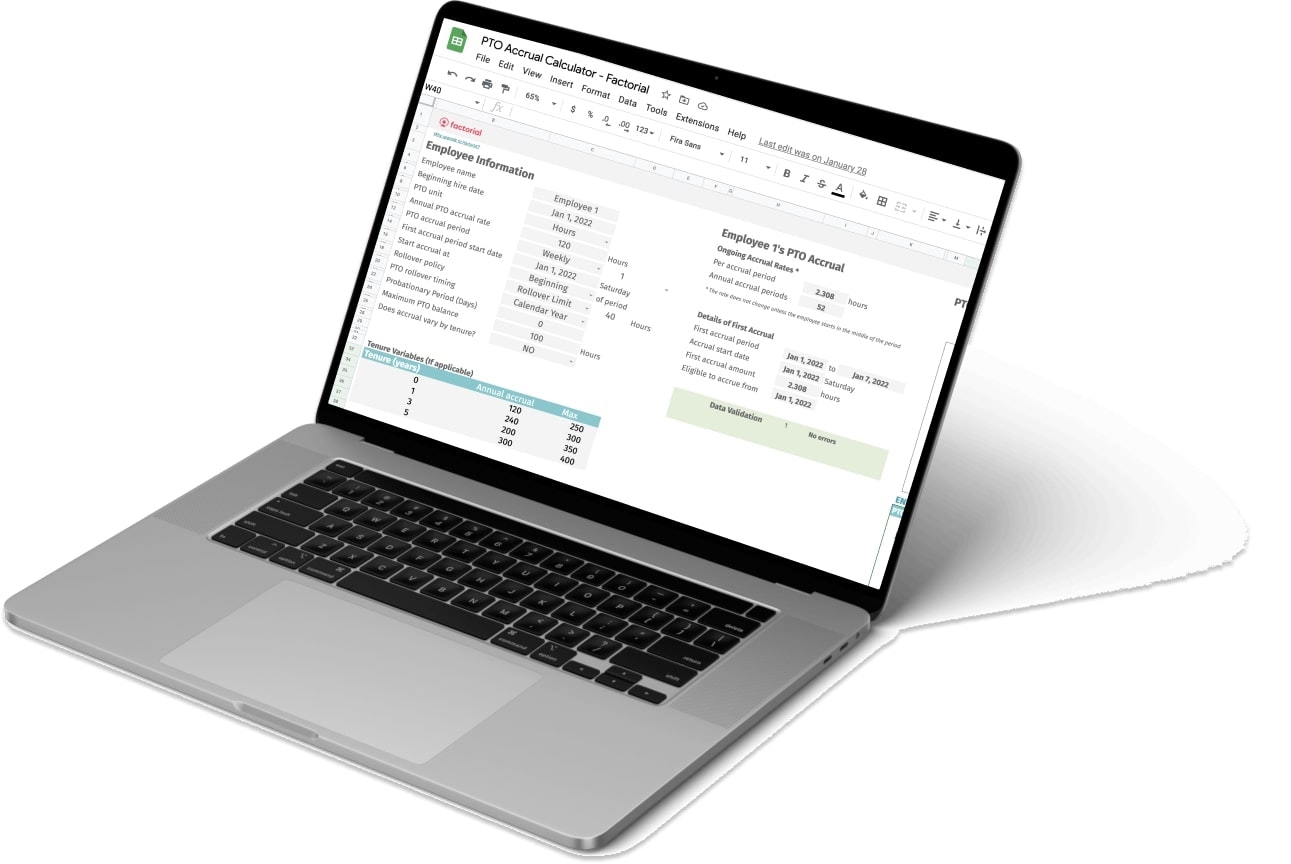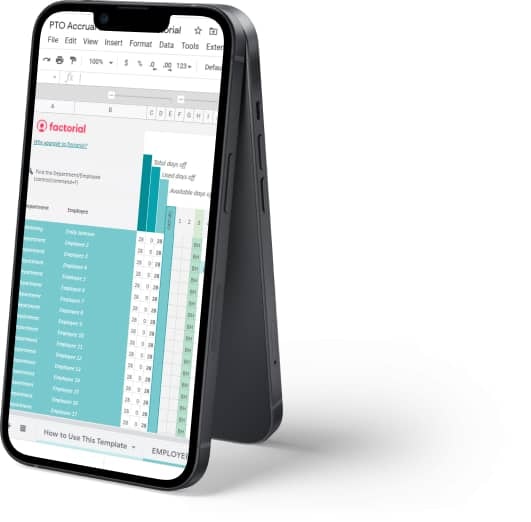Download the PTO Accrual Calculator
This resource is free! 🎉 Fill in the form to download our free google sheets template. We'll help you to keep track of employees' accrued PTO hours. With this template, you can customize calculations to the parameters of your company's PTO policy and set the duration and frequency of accrual cycles. With this template you can:
- Calculate based on weekly, monthly, bimonthly, and annual accrual periods
- Keep track of accrued PTO based on your company's rollover policy
- Visualize employee's current and projected PTO balance in a chart
- Keep track of employee's time off in 2024
- And more
Just fill out the spreadsheet with employee's information and your company's policy and let the calculator do the rest! 🚀

What is PTO Accrual?
Paid time off, also known as PTO, is any time an employee is being paid while away from work and not working. Types of time off requests usually cover leisure, medical, and family or personal obligations. In other words, these absences can be taken for vacations, illnesses, bereavement, or personal time off.
Although companies are not required by law to offer payment for time not worked, most companies include PTO in their leave of absence policy. They do this because a PTO policy contributes to employee engagement and retention, results in fewer unplanned absences, and gives companies a competitive advantage in terms of attracting talent to the company. It also makes it easier for employers in terms of workforce planning.
PTO accrual is time off an employee has earned but not yet used. Employees can accrue their PTO on an hourly, weekly, bi-weekly, monthly, quarterly, annual, or per pay-period basis. The way you calculate it will depend on your organization’s HR strategy. The best way for you to do this is by using a PTO accrual calculator, also known as a PTO accrual rate calculator.

How Much Annual PTO Should be Given to Employees?
According to the Fair Labor Standards Act (FLSA), there is no legal obligation to offer paid time off to your employees. Although some companies only offer unpaid time off, and others offer unlimited PTO vacation, most offer a limited number of days that can be taken as time off each year.
This means that there is no official “right answer” to the question “How much annual PTO should I give my employees’”. This needs to be something you decide as part of your leave policies, and whatever you decide needs to be applied consistently.
There are, however, a number of requirements that you do need to take into consideration. For one thing, you need to make sure you keep a record of all paid and unpaid time off in order to comply with FLSA recordkeeping obligations. You also need to comply with any state laws regulating time and attendance.
Finally, the PTO you offer your employees will also depend on the size of your company, and whether you hire salaried, hourly, or part-time workers. For example, employees working 40 hours per week and employees working less than 40 hours per week but not less than 20 hours are eligible to earn PTO hours on a prorated basis.

How to Calculate PTO Rate Accrual
-
When calculating PTO, there are a number of variables you need to consider. You need to establish how much PTO you will offer on an annual basis. You also need to define what your PTO accrual rate is, and how it will be applied if you have different groups of employees (salaried, hourly, and part-time). Plus, the length of your pay cycles will also have an effect.
All these variables mean that it can be complicated to calculate paid time off. This is why a PTO accrual calculator can be a valuable lifeline for employers. It helps you ensure you are calculating the right accrual rate. And this means you can be sure you are paying your employees the right amount each month.
Before we look at what a PTO accrual rate calculator is, let’s break down the different steps you need to follow to calculate your PTO accrual rate.
Decide How Much PTO You Will Offer
The first step is deciding how much PTO you will offer your employees per year. According to the Society for Human Resource Management, most companies offer an average of 18 days per year. It’s up to you to decide whether or not you will include paid holidays in this figure. The same goes for medical appointments and parental leave.
Establish Your Standard Hours Worked Per Week
The next step is calculating the standard hours worked by employees each week. This is easy enough if all your employees work a set 40-hour workweek. If you have a mixture of full-time and part-time workers then this can be a bit more complicated. This is where a PTO accrual rate calculator can come in handy. It gives you a more accurate accrual rate before you process your payroll.
Calculate Your Standard Available Work Hours Per Year
You also need to calculate your standard available work hours per year. In other words, how many work hours per year employees are eligible to accrue PTO. You will use this figure as your denominator when you calculate your PTO accrual rate.
Generally speaking, the standard available work hours per year used by most companies is 2,080. You get this figure by multiplying the number of weeks per year (52) by the number of hours your average employee works each year.
For example, if your employees work a standard 40-hour workweek and your company operates 52 weeks a year, then the calculation would be:
40 hours x 52 weeks = 2,080 hours per year
Following on from this, if, for example, you offer your employees two weeks of PTO each year, then they would get 80 hours of PTO per week (40 hours x 2 weeks).
Calculate Accrual Rate
You are now ready to calculate your accrual rate. You can do this by dividing PTO hours by total hours:
80 hours PTO / 2,080 hours per year = 0.038 hourly PTO accrual rate
So for every hour that an employee works, they accrue 0.038 hours of PTO.
You can use these calculations if your employees work a standard full-time 40-hour week. You will need to make adjustments to the PTO rate calculator process if you work with different payroll cycles. This is one of many reasons why you might find it difficult to calculate PTO accrual manually. It’s much easier to use an automated solution.
Let’s take a look at a couple of options that can make your life easier.
Using an Excel Template to Calculate PTO
-
A PTO accrual calculator is a great solution for streamlining the process. For example, you can use a PTO Calculator Excel to determine the right accrual rate to use per pay period. A “calculate PTO accrual Excel template” can also help you determine how much PTO employees earn each pay period. This helps you keep track of each employee’s PTO: what they have taken, and how much they have accrued. It also makes it easier when it comes to managing vacation requests. Plus, you get visibility of which employee is off and when which makes shift management and managing paid time off much easier to process.
We have created a downloadable Excel template so you can manage absences and vacations for your entire team. It is completely customizable and adaptable to your company. Just add in how many hours employees are eligible to work each year, how many hours they work on average each week, and how many days of vacation time you provide them. The spreadsheet does the rest!
Aside from using a PTO accrual calculator, the other option for managing PTO requests and PTO accrual is using absence management software. This can speed up and streamline the process. You also get more reliable data as manual methods like a PTO accrual calculator are always open to the potential of human error.
Most PTO tracking software also offers employers an automated leave management system. Your employees can send their time off requests for approval through the system. Your managers can then check how much PTO they have accrued. They can also see how much PTO an employee has already used before approving a request. Plus, with Factorial’s software solution, you can sync data with additional features. These include time tracking and payroll reporting to make sure you have access to all the right data in real-time. This will help your business run more smoothly and expediently, saving you time in the long run.
Save yourself the headache of managing PTO with Factorial’s holiday leave software. Sign up for your free trial today!